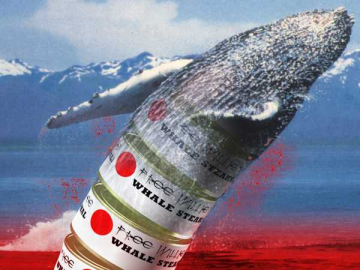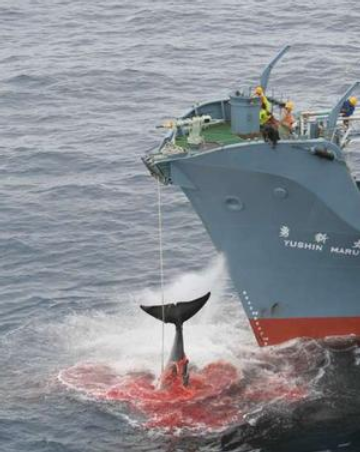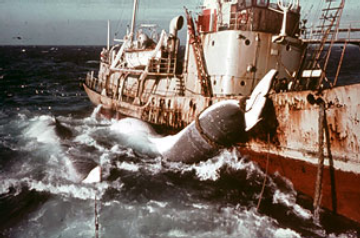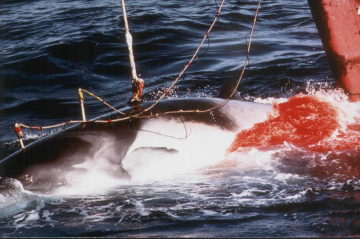The Land of the Dying Fin

Last week's bad news, the world's doomed future:
Fin whale to return to Japanese menus
By Andrew Darby, THE AGE
April 15, 2006
Fin whales, the world's second largest whale and to many whale-eaters the tastiest, are likely to make a comeback on Japanese menus.
Despite last summer's anti-whaling protests, the country's whaling fleet returned to the north-western port of Kanazawa yesterday with a haul of 10 fins and 853 minkes.
It was the largest single slaughter of whales since the moratorium on commercial whaling came into force in 1986, federal Environment Minister Ian Campbell said.
"Clearly this will add to a massive stockpile of uneaten whale meat that built up under a program only half the size," Senator Campbell said.
But Japanese officials said that fin would be available for consumption for the first time in years.
The fin is the second largest living animal after the blue whale. It can grow to 19 metres long and weigh up to 75 tonnes. With 725,000 fins killed last century in the Antarctic, it is still endangered.
Fin became a favourite meat in post-World War II Japan, and according to Masayuki Komatsu, executive director of the Fisheries Research Agency, it is considered to have the best flavour of all whale meat.
A Japanese Fisheries Agency deputy director, Hideki Moronuki, said that fin was last available from frozen stocks supplied by Iceland, which killed its last fins under scientific permit in 1989.
"You could only enjoy it a few years ago at very high price," Mr Moronuki said. "I expect now it will be available again in the next few months."
Animal welfare groups say that the 10 fin harpooned in Antarctica would have suffered long and painful deaths.
"The fin is six times the size of minkes, but they are using the same (killing) methods," said Darren Kindleysides, marine campaigner for the International Fund for Animal Welfare. "We have massive concerns about that."
Senator Campbell called on Japan to make public the results of its scientific whaling program, and to put the program on hold.
He said Japan should recognise that Australia and other anti-whaling nations achieved a majority in rejecting the program at the last International Whaling Commission meeting.
The whales are taken under IWC regulations that allow any member country to kill whales for scientific research, and that require the "by-products of research" to be sold.
As well as the fin whales, Japan awarded itself a quota of 850 minkes, plus or minus 10 per cent.
"Of course we had difficulty achieving this because of the dangerous acts of Greenpeace and Sea Shepherd, but thanks to the endeavours of our researchers, we could achieve our purpose," Mr Moronuki said.
Shane Rattenbury, of Greenpeace International, said that the fishing companies that owned the whaling fleet had decided to sell it.
The fleet-owning company, Kyodo Senpaku, is being turned over to a group of non-profit organisations, including the Japanese Government's Institute for Cetacean Research.
Mr Rattenbury also said that, with whale-meat stockpiles growing, a small amount of whale meat was being sold as pet food.
The Japanese Government believes it will be able to secure a simple majority of votes at the next IWC meeting in June.
This would be enough to obtain backing for its continued research, and change the way the IWC operates. But the meeting is unlikely to generate the three-quarter majority needed to end the moratorium on commercial whaling.


Pro-hunting Japanese seize control of whaling commission
Through a lengthy, covert operation, Japan is poised to seize control of whale hunting - and that spells disaster for the endangered mammal
BELFAST TELEGRAPH, 17 April 2006
The environmental movement is facing one of its biggest-ever reverses, over one of its most cherished causes: Save The Whale.
In a remarkable diplomatic coup, Japan, the leading pro-whaling nation, is poised to seize control of whaling's regulatory body, the International Whaling Commission (IWC), and so hasten the return of commercial whale hunting, which has been officially banned worldwide for the past 20 years.
While the world has been looking the other way, the Japanese have spent nearly a decade and many millions of dollars building up a voting majority in the IWC, by buying the votes of small member states with substantial foreign aid packages.
Their aim is to reverse the moratorium on commercial whaling brought in by the IWC in 1986 as a result of the long Save The Whale campaign by Greenpeace and other environmental pressure groups.
This has always been seen as of one of the environment movement's greatest success stories.
But anyone who opposes killing the great whales, or who thought that the main battle against the harpooners had been won, is in for a nasty surprise when at the IWC meeting in the West Indies, two months from now, this new majority is likely to become clear, and to be exercised for the first time. It will be a huge propaganda victory for the Japanese and the other nations determined to continue whale hunting, principally Norway and Iceland.
The simple majority (51 per cent- plus) of votes the Japanese and their allies are virtually certain to command at the June meeting in St Kitts and Nevis will not enable them to scrap the moratorium outright - that needs a voting majority of 75 per cent.
But it will enable them to reshape the IWC comprehensively in a much more pro-whaling fashion - by stopping all its conservation work, stopping all discussions of animal welfare in relation to whaling, and promoting the trade in whale products.
It will also allow them to get resolutions passed approving Japan's so-called "scientific" whaling - the commercial whaling in disguise the Japanese have continued since the ban. (This year they are hunting nearly 1,000 minke whales in the Southern Ocean). Although their pretence of killing the animals for research fools no one - the meat is sold commercially - the Japanese are anxious for it to be given international legitimacy, in the face of continuing worldwide criticism.
But perhaps most significantly of all, the majority vote will enable the introduction of secret ballots in the IWC - where voting is at present open. This will mean that Japan's vote-buying can no longer be tracked, and will open the way for more countries to join the Japanese in their quest to have the moratorium ultimately overturned.
"Japan achieving a majority in the IWC is going to be an environmental disaster, yet the world seems unaware that it is about to happen," said Vassili Papstavrou, from the International Fund for Animal Welfare, who has carefully followed the Japanese build-up of supporting countries. "Countries that oppose whaling have done almost nothing to stop it."
Although the Japanese have always defiantly refused to accept the international whaling ban, despite world opinion, it was not until about 1998 that they set out on a deliberate course to take control of the institution which brought it in.
They did so by a form of entryism - encouraging small, poor countries to join the IWC, most of which had no previous whaling tradition at all, and some of which - such as Mali and Mongolia - did not even have a coastline. In return, the new IWC members were given multimillion-dollar aid packages.
The Japanese have targeted two groups of nations in particular - states in west and north Africa, and small states, often islands, in the Caribbean and the Pacific. Largely as a result of this, the IWC, which had 40 members in 2000, now has 66.
It is likely that the full total of supporting states Japan has brought into the IWC since 1998 is 19; they can all be shown to be clients of Japan by the consistency of their IWC voting records. They can also be shown to be in receipt of substantial Japanese largesse.
For example, the Republic of Guinea, which joined the IWC in 2000, in 2002 received $6.55m in Japanese aid for construction of a fish market in Conakry, the capital.
For small, often desperately poor nations, these are sizeable and very tempting sums.
The end result has been a dramatic shift in the IWC voting balance. Ten years ago, when there were 35 active member states, the pattern was 11 or 12 voting with Japan and 22 or 23 opposed.
But by last year's IWC meeting at Ulsan in South Korea, the Japanese had, on paper, a voting majority of 33-30 of the 66 IWC members (three anti-whaling member states, Peru, Kenya and Costa Rica, being unable to vote because they are behind with their subscriptions).
Yet four Japanese client states - Belize, Mali, Togo and the Gambia - failed to turn up for the meeting, and so the Japanese were voted down, much to their anger.
Japan's leading representative at the meeting, Akira Nakamae, said at the time: "Our side's supporters are about to reach a majority soon.
"Some of you are so glad that some poor countries could not attend this meeting.
"However, next year they will all participate, and the reversal of history, the turning point, is soon to come."
An ineffective ban
* Commercial whaling has been banned since 1986 except for "scientific" purposes.
* Norway resumed commercial whale hunting in 1993, and Iceland followed in 2003.
* Despite widespread international opposition, Tokyo plans to kill 1,070 minke whales this year, 400 more than in 2005 and double the number it hunted a decade ago.
* More than 2,000 whales are likely to be hunted by Japan, Norway and Iceland this year in defiance of world opinion.
* Japan's fleet is legally allowed to hunt about 1,000 whales a year for "research purposes" and since the 1986 ban it has killed more than 5,000 minke whales.
* Despite the pretence of killing the animals for research, most of the meat is sold commercially.

Bastards.
Labels: Say Goodbye to...




2 Comments:
terrible too bad =c I dont like this situation
By Lots for sale in Costa Rica, At
12:16 am
Lots for sale in Costa Rica, At
12:16 am
Well I don't really have words for this, the situation on the planet it's getting worse in all ways.
Thanks for sharing, nice post.
By viagra online, At
6:23 pm
viagra online, At
6:23 pm
Post a Comment
Subscribe to Post Comments [Atom]
<< Home